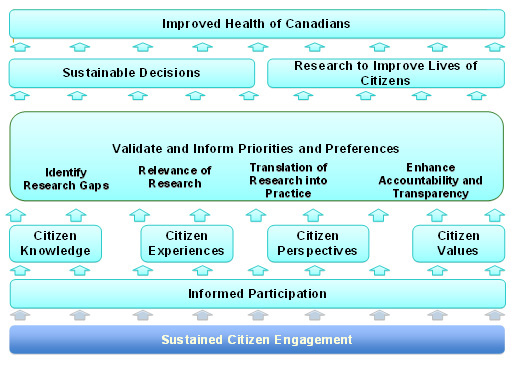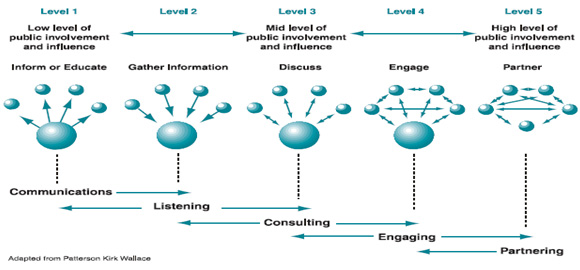CIHR’s Framework for Citizen Engagement - Section One: Introduction
[ Return to Table of Contents ]- 1.1 Developing the Citizen Engagement Framework
- 1.2 What the CIHR Citizen Engagement Framework will do
The mandate of the Canadian Institutes of Health Research (CIHR) requires that it not only create new knowledge, but translate that knowledge into improved health, a strengthened health-care system and new health products and services.
The CIHR Knowledge Translation (KT) Portfolio has identified citizen engagement (CE) as playing a key role in achieving the KT imperative of CIHR's mandate and, on behalf of CIHR, is moving forward in realizing a more systematic, ongoing integration of citizens' input in research priority setting, governance and in funding programs and tools. The Act (Bill c-13) that created CIHR expressly directs the organization to achieve its mandate by encouraging interdisciplinary, integrative health research which includes engaging voluntary organizations, the private sector and others, in or outside Canada, with complementary research interests. It also requires CIHR to ensure transparency and accountability to Canadians for the investment of the Government of Canada in health research.Footnote 3
CIHR has developed this CE Framework as a means to engage citizens effectively and systematically in its work. It has adopted the term citizen engagement because the essence of "engagement" is far more active than traditionally passive public "consultation", which may not always recognize the capacity of citizens to discuss issues effectively or generate options independently.
At the heart of the concept of CE lies a desire on the part of the organization to align its priorities with those of citizens and a recognition that CE requires more active involvement of citizens over a significant period of time, ideally through substantive, deliberative, in-depth consideration of values and principles. CE activities give us the opportunity to be open and transparent in our processes, and accountable for our decisions. CE processes, by definition, wield their accountability through the formation of strong relationships that are built upon trust, openness and responsiveness between citizens and government or public institutions. In other words, through the design of CE processes that "encompass dialogue and issue recommendations based on a real array of choices ...[through] open-ended yet structured public dialogue"Footnote 4, the public contributes to decisions in a transparent, publicly accountable manner. Instead of holding the threat of sanction, CE mitigates the need for sanction and its associated threats of public exposure and negative publicity. As such, a strong culture of CE renders the sanction tool less pivotal.Footnote 5
CIHR's CE Framework will establish guidelines for implementing a more systematic approach to consulting and engaging citizens in the work of CIHR, such as in assessing the merit and relevance of research applications, developing strategic plans, setting research priorities and strengthening membership on CIHR governance structures.
The following conceptual model (Figure 1) represents the value of sustained CE for CIHR:

Fig. 1: The Benefits of Sustained Citizen Engagement
Figure 1 positions CE for CIHR and provokes thinking on the benefits and value of sustained engagement. The model is meant to be read from bottom to top: Informed participation leads to gathering citizen knowledge, experiences, perspectives and values. These inputs are used to validate and inform priorities and preferences, which will then contribute to improving the relevance of research, the translation of research into practice, the identification of research gaps, and CIHR's accountability and transparency. The long-term outcomes are more sustainable decisions and research to improve the lives of citizens.
1.1 Developing the Citizen Engagement Framework
CIHR's CE Framework was developed through two main activities: a situational analysis of CE activities and programs from select research agencies in Canada (and abroad) and from regional health authorities within Canada; and an internal survey of Institutes and relevant Branches within CIHR, as well as Health Canada (HC) and the Public Health Agency of Canada (PHAC). Activities were analyzed in the context of Health Canada's five levels of public involvement, which include: 1) inform and educate, 2) gather information, 3) discuss, 4) engage, and, at the highest level of involvement, 5) partner. (Please see the Figure 2 below; further information about this continuum can be found in Appendix 2.)

Fig. 2: The Five Levels of Public Involvement
To stimulate deeper discussion and gain more feedback about CE in the CIHR context, a consensus-building workshop with relevant staff from CIHR Institutes and Branches was held in May 2008. A CIHR Citizen Engagement Working Group, struck in 2007, with representation from staff across the organization (including Communications, Research, Ethics, Knowledge Translation and Institutes) has also provided guidance and advice on the development of the Framework and the overall organizational strategy. (Results from these activities can be found in section 2.2.2, below.)
1.2 What the CIHR Citizen Engagement Framework will do
The focus of CIHR's framework is the effective engagement of citizens at the higher levels of Health Canada's public involvement continuum, as described in Appendix 2, which support collaborative decision-making and partnering. Currently, according to the internal survey (described in more detail in Section 2), 80% of CIHR's CE activities are clustered around levels 1-3 of the continuum, with only 20% of the captured activities promoting longer-term engagement and partnering.
The Framework establishes guidelines and standards for evaluating gaps in our activities in which we would like to include the voices of citizens. A Handbook tailored to CIHR's programs and decision-making committees will also be created to accompany this Framework. It will outline the methods, processes and checklists that can be used by CIHR staff members for specific levels of CE. Staff professional development will be critical in order to ensure that CE processes are managed well, but also to avoid situations that have occurred in other organizations, where citizens take part in decision-making meetings and/or consultations but are not provided with the results of these exercises or how their input was used. This simple oversight contributes to public distrust of and cynicism about these exercises.
The Framework builds on the considerable, although variable, CE activities already underway at CIHR, including:
- Institute Advisory Boards;
- The Knowledge Exchange Task Force (KETF), an initiative of CIHR's Institute of Musculoskeletal Health and Arthritis. Created in 2004, the KETF is an innovative communication pathway linking researchers and key stakeholders, including clinicians and patients. Members become 'Research Ambassadors' in the dissemination of research findings to their respective organizations and communities.
- Regional Seniors Workshops conducted by CIHR's Institute of Aging in 2004, which involved extensive consultations with senior citizens for the purpose of informing future research priorities.
- The Community Reviewer program. Community Reviewers participate on peer review panels and are asked to comment on the extent to which lay abstracts are well explained and in language that is clear to members of the general public.
- The community-based research program, part of HIV/AIDS and STBBI Research Initiative. This program includes equal representation from experts and community representatives, including patients and community organizations, on its merit review committee.
Further examples of CIHR CE activities can be found in Appendix 1.
As CIHR implements its CE Framework, it will also incorporate other initiatives and promising practices, both within the Government of Canada's Health Portfolio and internationally. For instance, PHAC is undergoing a similar exercise as it implements its own framework, entitled Public Involvement Framework: Involving the public in public health decision-making. HC is currently updating its Policy Toolkit for Public Involvement in Decision Making and is undergoing some restructuring of its oversight and consultation services to its branches. Discussion and collaboration will continue as these initiatives within the Health Portfolio evolve.
A relevant and very timely activity being spearheaded by the Global Science Forum of the Organisation for Economic Co-Operation and Development (OECD) involves a study that will examine consultation practices in order to develop more effective dialogue between science and society. The related workshop brought together policy makers, science advisors and representatives of research institutions to exchange and evaluate the experiences of various countries. The reflection helped to bring science policy makers and the general public closer together, and to influence the practice of democracy. It is important to note, for our purposes, that the underlying principle for this activity is that true dialogue (that goes beyond traditional science education) is necessary as citizens refuse to be passive recipients of new products and technologies, however innovative they may be.Footnote 6
This Framework is divided into specific sections. Section 2 sets out the context within which CE operates by defining the concept and providing an overview of CE in other research funding agencies, within CIHR, and within the Government of Canada's Health Portfolio. Section 3 outlines the Framework itself, including the general principles underlying it, its objectives, implementation and how it will be evaluated. Section 4 provides a brief conclusion, while Appendices 1-6 are included to provide the reader with relevant background material and survey results.
"Public involvement complements scientific research and evidence, and directs new research."
- Date modified: